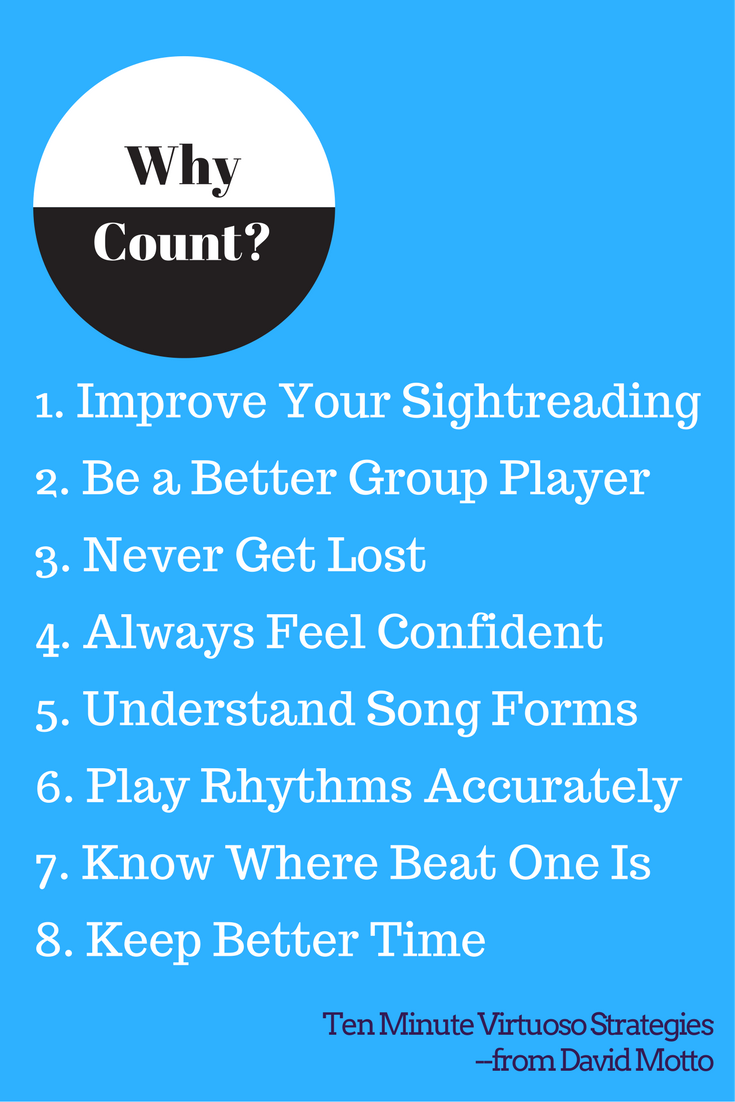David Motto’s Practice Tip of the Week:
The Best Counting Methods
One of the top pieces of advice music teachers give their students is to count all the time while they’re playing. Keeping the count allows musicians to improve their sightreading, be better ensemble players, and to never get lost.
Counting While Sightreading
When you sightread (whether reading written-out notes or chord charts), you must count as if your life depends on it. Here are two counting rules for sightreading:
1. Never Stop Counting: You can never stop the count while reading unfamiliar music. If you get tired of counting, you should just count with even more concentration, raising the volume of your inner voice to make sure you’re paying attention!
2. Subdivide: Subdivide your count to match the fastest notes on the page.
- If there are eighth notes in your music, then count eighth notes (“1 and 2 and 3 and 4 and”). Subdivide even in the bars that have only larger note values.
- For a song in 6/8, 12/8, or even 4/4 with a ton of triplets, subdivide your count into triplets. (“1 and uh 2 and uh 3 and uh 4 and uh”)
- If you see sixteenth notes, then subdivide your count into sixteenths. (1 ee and uh 2 ee and uh 3 ee and uh 4 ee and uh.) Make sure you start this process before you get to the bar with the sixteenth notes in it!
Improving Rehearsals and Performances
Many people, especially those who regularly rehearse and perform in a group, rely on other musicians to help them keep their place. Well, wouldn’t it be great if you were the person everyone else relied on? You would be an asset to the group, you would feel in control of your music, and you would contribute to a better ensemble experience.
And, you’d be more relaxed. And confident. You might even have more fun!
Working on counting in the practice room gives you confidence in rehearsals and performances. Try these two strategies to improve your group playing:
1. Count the Song Form: When you know where you are in your music, you can cue other musicians and make stronger transitions. Be sure you know how many bars are in each section of your songs.
2. Focus on Downbeats: Always make sure you know where the downbeat (beat one) of each measure is. If you don’t know where beat one is, you could easily get lost. Actually, it is highly likely that you will get lost.
How Counting Redefines Success
The counting process needs to be worked on at every practice session and can actually re-define what it means to practice, learn, and master a sequence successfully.
Most musicians feel they are successful when they play all of the correct pitches—even if they accidentally stretched time a bit to get to all those pitches.
However, you view success differently if your focus is rhythm and time. Keeping all the rhythms intact—even at the expense of missing a couple pitches—could be seen as more successful than getting pitches while missing rhythms.
After all, this is what must occur during a rehearsal or performance. If you miss a specific note while on stage, the rest of the musicians do not slow down so you can go back and correct that pitch! So, make sure your practicing is not always focused on pitches. Focus on the count and the rhythms.
If you are having difficulty keeping the count in your head while playing, then count out loud while playing. This is extremely difficult (especially for wind players!!) and forces you to slow down to a speed where you can both play and count.
Summary of Counting Strategies
Here’s my list of strategies in this Practice Tip of the Week:
1. Never stop counting while sightreading.
2. Subdivide your counting to the fastest rhythm you need to control.
3. Be the person who knows song forms, so you can lead other musicians.
4. Always know where Beat One is.
5. Play songs where keeping the rhythm intact is the main goal.
6. Count out loud.
7. Slow down if you need to, in order to count and play at the same time.
To Your Musical Success!
David Motto


Terence – There are many ways to go about counting subdivisions. I recommend that musicians new to the concept start with counting quarter notes and 8th notes. This will get you used to the idea of taking one beat of music and breaking it into equal parts. Your teacher can show you how to do this. There is also help available online. Try this: https://www.google.com/search?q=sibdivide+beats+music. If you’re interested in mastering subdivisions by working directly with me, I’m also available to coach you: http://davidmotto.com/coaching/music-performance-coaching/
Do you have anymore tips on Subividing. I’m having a hard time grasping it. Even with my music teacher.
Thanks
Terence